Power Bank Why And How To Choose The One That’s Right For You

I have run out of smartphone battery several times during a shooting day.
A few years ago, I thought it was not essential to use an additional battery for your smartphone, but I changed my mind over time.
The world of Power banks is getting bigger and bigger
Raise your hand if you ever run out of battery and couldn’t charge your phone? This has happened to me more than once, and so I decided to buy a power bank for my needs.
A Power bank is nothing more than a compact and portable charger that you can take with you to power phones, tablets and more.
In addition to being able to charge your smartphone on the go, below you will find a list of reasons why you should buy a Power Bank; to give a complete view, I also decided to hear the friends of PowerBank20, who are in charge of testing and reviewing all the power banks on the market, find their answers below.
The reasons that should make you buy a Power Bank:
While the central focus is usually on charging phones and tablets, with power banks you can charge lots of accessories.
When I bought the first power bank, I realized that it would become “my best friend” since it “saved” me a walk, not because I had a dead mobile phone, but because my Bluetooth headphones had run out (when I walk I enjoy listening to audiobooks for self-improvement).
With the right power bank, you can charge or power almost anything, including different devices like laptops, eBook readers, kindles, fans, lamps, printers, drones, vacuum cleaners, humidifiers, string lights, handheld massages, cameras, and Go Pros.
I’ve seen power banks used to charge a Nintendo Switch via the included USB Type-C port.
The AC output allows that appliance to obtain the same amount of energy that it would get from a standard socket at home. Many appliances can connect, however, if the required power is higher than the power bank can provide, it will not work.
Therefore, it is important to check in advance if the device is compatible. Power banks with an AC output are not common, but they provide that little bit extra to make sure you can charge [almost] anything.
It is a sharing tool:
A power bank is not just about your personal recharge, it is definitely a sharing tool. Has it ever happened to you to “scrounge” the recharge of someone who had a power bank?
It is certainly a convenience, but it is also a great way to better manage family recharges, and also an excellent tool for making new friends.
They can be taken absolutely anywhere
Everyone wants to buy a power bank because they are lightweight, affordable, and most importantly, portable!
In fact so portable, people have started taking them really everywhere. From a bike ride to a walk on the road to a mountain hike, you will notice these little chargers everywhere.
Partly because of their flexibility, manufacturers have responded by including a number of safety protections to ensure they can be used regardless of the environment. These protections include dust and water protection.
Some power banks even have shells that are more resistant to shocks and thicker in case they fall from a height. I don’t know if a power bank has reached space, but I’m sure if it hasn’t already happened it will surely happen.
Features to choose the right power bank for you:
What features the perfect power bank must-have. To give a timely answer to the question, as I mentioned earlier, I asked the friends of PowerBank20 for a hand, a team of 3 guys who independently test all the power bank models on the market, and make their expertise and all available. the tests to choose the best power bank for your needs.
Let’s start with the questions immediately:
I personally struggle to extricate myself from the thousands of offers and the number of products available on the market. In practice, where do you start to make a choice?
First of all, you should ask yourself, with what types of devices do you plan to use the power bank and how often do you use it?
For example, if you need a power bank for your smartphone to use every day because its battery barely makes it to the end of the day, then a 10000mAh capacity model is more than enough for its weight and size. , it is very comfortable to carry in your pocket or on some pocket of a backpack, without taking up too much space.
Instead, if you are looking for a power bank to take on the go and you need it to have enough energy to recharge your smartphone several times or also recharge other gadgets (tablets, earphones, cameras, eBooks, a friend’s smartphone …) we believe that a power 20000 mAh bank with 2 or 3 USB ports is ideal for its size and weight.
Once you understand the main use of the power bank, you need to think about the technology that it can include and in your budget.
Usually, we recommend that the power bank have the new USB C port (reversible) and the Quick Charge 3.0 and/or Power Delivery (PD) technology in both the input (charging the power bank) and the output port. (charging of devices).
Furthermore, in models with large capacity (20000mAh or higher), we consider it almost essential that the input port has fast charging to avoid too many hours waiting for it to recharge to 100%.
Of course, you will also need to use a charger compatible with the fast charging of the power bank (QC 3.0 and/or PD) if you want to take advantage of this technology.
Obviously, buying the latest technology has a higher price and, at this point, you have to evaluate whether it is worth having the latest-generation power bank (together with a charger) if your smartphone has no fast charging or USB C port and you don’t intend to replace it in a while.
In the last period I have seen that there are many Power banks to recharge laptops or mac books, are they valid and reliable products such as power banks for mobile phones?
We recently published a new guide where we explain in-depth the options that exist to recharge any laptop and the types of power banks that can be used according to their charging port and the power it can provide.
Thanks to the tests carried out on this guide, we can confirm that it is an absolutely valid and recommended product, provided that the user knows how to choose the correct model taking into account the voltage at which the laptop is charged, the power that the power bank can provide and the use of the computer itself, for example, cannot be compared to playing video games (results in a higher consumption) with surfing the internet.
Furthermore, a power bank for laptops can be a very useful option for those people who cannot replace the dead battery of their laptop and must always use it plugged in.
I happen to take long walks in the mountains with my family and often use my mobile phone with different applications, my favorite is Picture This, which allows you to recognize the type of plant by taking a photograph, this involves high consumption of the battery of my smartphone. Can you give me a couple of suggestions on which Power bank to buy? Is it portable, has a good capacity, and can also charge my wife’s cell phone?
You could use a power bank with an integrated solar panel, so you can carry it hanging from your backpack and so it recharges while, for example, taking a walk.
Very complete and ideal for the situation you tell us:
- 20000 mAh capacity
- 300mA solar panel
- Integrated compass
- LED lantern
- x1 Wireless charging area 10W max
- x2 USB input ports (x1 USB-C + x1 micro-USB) with 18W PD and QC 3.0 fast charging respectively
- x3 USB out ports (x1 USB-C + x2 USB-A) with QC 3.0 fast charge (x1 USB-A) and 18W Power Delivery (x1 USB-C)
Finally, tell me about the tests you do on the various power banks and how to read the test results to refine your search when choosing a power bank?
First of all, we must point out that on our homepage we list the 20 best power bank models, among which there are models already tested by us and which have passed our recommendation criteria and models we are analyzing and, due to their characteristics, we find it interesting to buy for our readers.
Of course, if after the analysis those models do not correspond to our expectations, we withdraw them from the ranking.
That said, when buying a power bank on Amazon we carry out 2 main tests:
Energy efficiency test in charging/discharging
For example, a 20,000 mAh (or 20 Ah) capacity power bank has an internal battery that stores 74 watt-hours (Wh) of energy, which is the result of multiplying the battery’s capacity and nominal voltage (usually 3.7 volts). :
Stored energy = 20 Ah x 3.7V = 74 Watt
In our tests, we discharge the power bank with an electronic load at a certain power depending on the type of discharge (or recharge of the device) that allows the model: standard (10W), rapid QC 3.0 (14W), or Power Delivery (14W, 24W or 40W).
Once the power bank has been discharged, we check the energy it was able to provide and with that, its energy efficiency (energy supplied / energy stored).
For example, in the following image we compare various models of 20,000 mAh now analyzed where we observe both their energy supplied and their energy efficiency in the standard discharge (without QC 3.0 and/or PD technology):
We consider a power bank as good if its discharge energy efficiency is 85% or more.
Equally, we measure both time and energy efficiency in charging, that is, the amount of energy that must be supplied to the power bank to fully recharge.
Following with the previous example, but now in standard charging, we can compare the energy efficiency and charging time in the same 20,000 mAh models:
And at this point, we want to remind you of the importance of a 20,000 mAh power bank with fast charging by comparing the charging times of various models, in this case, with Power Delivery in their input port (USB-C):
You can appreciate how there are 20000mAh power banks that are capable of recharging in approximately 3.5 hours (with a suitable charger) in comparison with other models that their charging time is 10 or 20 hours because they do not have fast charging in their door to the entrance.
Finally, all the data we get on these tests we record them on a table that any curious user can consult in our Power bank Test section.
Power Test:
The specifications of a power bank usually indicate the power that each of their USB output ports can provide, for example:
If the USB output port of a power bank indicates 5V / 2.1A it means that the maximum power it can supply is 10.5W (5V x 2.1A)
On this test, we check the maximum individual power each of a power bank’s USB output ports can provide and the maximum total power of all their ports at the same time.
Likewise, this evidence is also recorded on a table which, unfortunately, is not yet visible to the public. Despite this, we also have this into consideration in our criteria for choosing the 20 best models.
Conclusion:
I thank the guys from Powerbank20 very much for their availability, and I am going to look for a new power bank to buy, for me, they have also become objects to collect.


